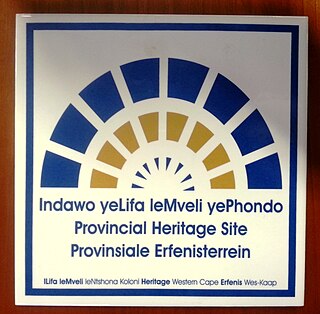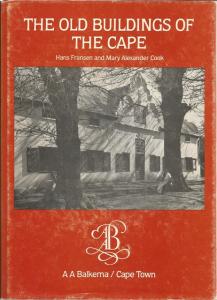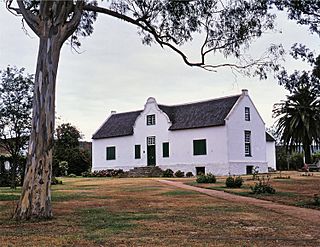
Stellenbosch is a town in the Western Cape province of South Africa, situated about 50 kilometres east of Cape Town, along the banks of the Eerste River at the foot of the Stellenbosch Mountain. The town became known as the City of Oaks or Eikestad in Afrikaans and Dutch due to the large number of oak trees that were planted by its founder, Simon van der Stel, to grace the streets and homesteads.

Groote Schuur Hospital is a large, government-funded, teaching hospital situated on the slopes of Devil's Peak in the city of Cape Town, South Africa. It was founded in 1938 and is famous for being the institution where the first human-to-human heart transplant took place, conducted by University of Cape Town-educated surgeon Christiaan Barnard on the patient Louis Washkansky.

Swellendam is the fourth oldest town in South Africa, a town with 17,537 inhabitants situated in the Western Cape province. The town has over 50 provincial heritage sites, most of them buildings of Cape Dutch architecture. Swellendam is situated on the N2, approximately 220 km from both Cape Town and George.

Groot Constantia is the oldest wine estate in South Africa and provincial heritage site in the suburb of Constantia in Cape Town, South Africa.

Cape Dutch architecture is an architectural style found mostly in the Western Cape of South Africa, but modern examples of the style have also been exported as far afield as Western Australia and New Zealand, typically on wine estates. The style was prominent in the early days of the Cape Colony, and the name derives from the initial settlers of the Cape being primarily Dutch. The style has roots in medieval Netherlands, Germany, France and Indonesia.

Provincial heritage sites in South Africa are places that are of historic or cultural importance within the context of the province concerned and which are for this reason declared in terms of Section 28 of the National Heritage Resources Act (NHRA) or legislation of the applicable province. The designation was a new one that came into effect with the introduction of the Act on 1 April 2000 when all former national monuments declared by the former National Monuments Council and its predecessors became provincial heritage sites as provided for in Section 58 of the Act.

Dutch colonial architecture refers to the various style of Dutch architecture built across the Dutch Empire. Though most of the buildings were designed by Dutch architects and dictated by Western architectural styles, even the most ardent style-purists among architects could not escape the forces of context and culture. Dutch colonial architecture often is a result of climatological adaptations or the use of local building materials - and more importantly, the rich and diverse cultural contexts. In this hybridity lies the quality of these buildings. Architecture shows that the strict racial taxonomy of a colonial system could not be maintained.

Burgersdorp is a medium-sized town in Walter Sisulu in the Joe Gqabi District Municipality of the Eastern Cape province of South Africa.

Assegaaibosch Nature Reserve is a historic estate and currently a CapeNature nature reserve and World Heritage Site situated in the Jonkershoek Valley near Stellenbosch in the Western Cape province of South Africa. The historic estate was established by Dirk Coetsee, the progenitor of the Coetsee family in South Africa.

George Museum is a cultural history museum located in the town of George, Western Cape, South Africa. It preserves the history of the town of George with a special focus on the timber industry. It also houses an art collection. The museum was started by Charles Sayers, in 1967 in a single room in Courtenay Street. The museum is now housed in the building the first magistrate, Adrian van Kervel built as the Drostdy (residency) from 1812 -1815.

The Old Buildings of the Cape is a book by Hans Fransen, subtitled in its latest edition A survey of extant architecture from before c. 1910 in the area of Cape Town–Calvinia–Colesberg–Uitenhage. It lists extant and lost buildings and structures in the Cape Province of South Africa. First published in 1965 and since updated, the book is a widely recognised desk reference on the subject.

Heritage Western Cape (HWC) is a provincial heritage resources authority established by the Minister of Cultural Affairs and Sport of the government of the Western Cape province in South Africa. It is a public entity set up under the terms of the National Heritage Resources Act. It is mandated to care for that part of South Africa's national estate that is of provincial and local significance in the Western Cape. It may delegate responsibility for heritage resources of local significance to competent municipal governments.
Dr Mary Alexander Cook was an expert on Cape Dutch architecture and a museum curator.

Coetsenburg is an historic wine estate and one of the oldest estates in South Africa, established in 1682. It is located at the foot of the Stellenbosch Mountain, which forms part of the estate, in the town of Stellenbosch, 31 miles (50 km) east of Cape Town, in the Cape Winelands of the Western Cape Province. The estate has historically been owned by the Coetsee family and is currently not open to the public. The north-western portion of the original estate is now the Coetsenburg Sports Grounds which belongs to the University of Stellenbosch.
Dirk Coetzee/Coetsee was a Dutch colonist and the Hoofdheemraad (Chancellor) of the District of Stellenbosch and Drakenstein in South Africa for most of the 1690s and early 1700s. He also served as captain of the Stellenbosch Infantry and deacon of the Stellenbosch Moederkerk at different points in time. As captain of the Stellenbosch Infantry, which comprised mostly Huguenots, he provided military backing for a rebellion which began in 1706 against the Governor of the Cape Colony, Willem Adriaan van der Stel, whom the vrijburghers had accused of tyranny, corruption and racketeering. Coetsee was imprisoned in the dungeon of the Castle of Good Hope along with the other leaders of the Huguenots but he was released after a year. The rebellion ultimately succeeded in 1707 when the Dutch East India Company recalled the Governor and other colonial officials. An account of the rebellion is vividly described in the "Diary of Adam Tas".
Johannes Henoch Neethling (1770-1838) was a South African Cape Supreme Court Judge and Grand Master of the Freemasons in South Africa.

Cuyler Manor, or Cuyler House, is a historic house museum in the Western Region of the Eastern Cape province of South Africa. Cuyler Manor was designated as a Provincial Heritage Site on March 14, 1980. In addition to the farm house, the visitor house, coach house, wagon house, and mill house are protected historic sites, all located between the Swartkops River and a South African Railways facility.
























